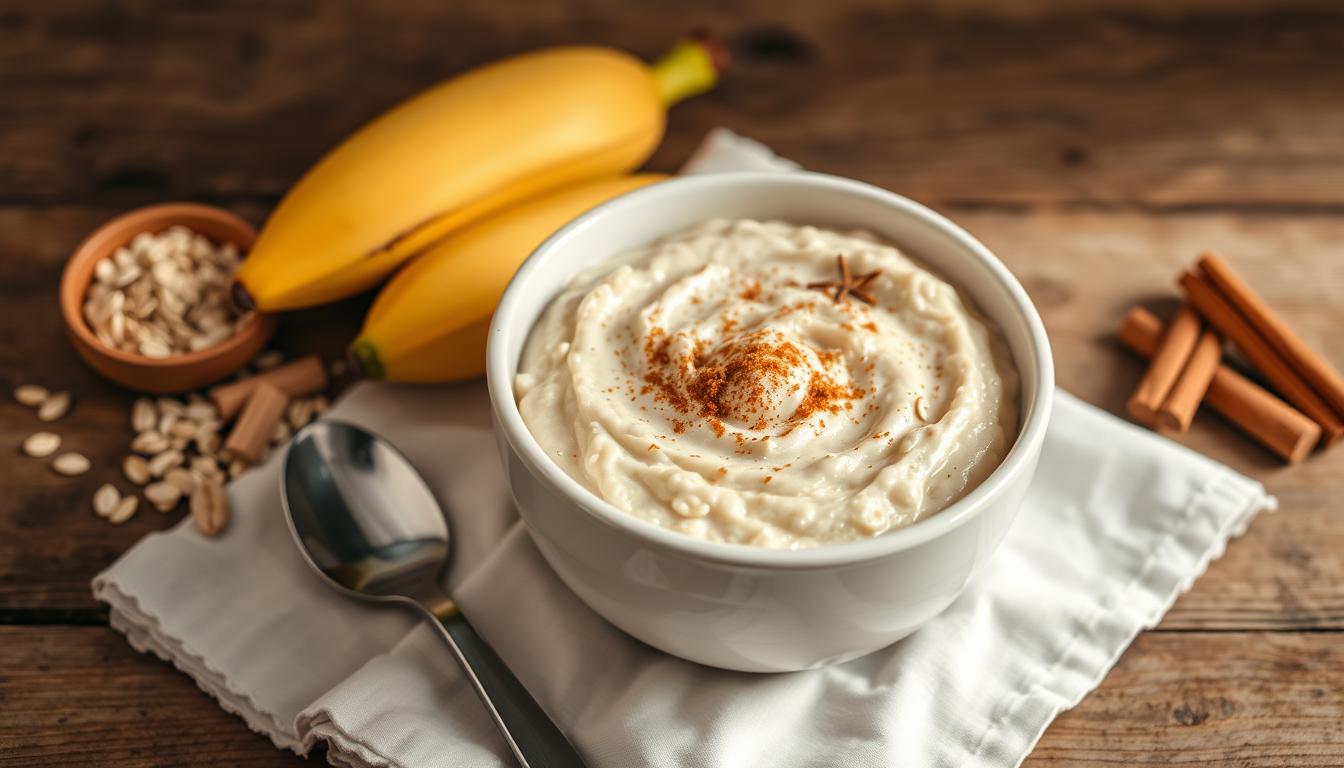Introducing your baby to solid foods is an exciting yet nerve-wracking experience. Homemade baby oatmeal is a great choice. It’s packed with nutrients and has a soft texture that’s easy for babies to digest.
Picture the joy of feeding your baby a warm oatmeal bowl. The smell of oatmeal fills the kitchen. Oatmeal for babies is a big step, making meals nutritious and easy from 4-6 months. This baby oatmeal recipe helps your baby start their food journey right.
Table of Contents
Why Oatmeal is the Perfect First Food for Your Baby
Oatmeal is a top pick for introducing solid foods to your baby. It’s nutritious and easy to digest. This makes it perfect for a first food. Oatmeal is full of vitamins, minerals, and fiber, helping your baby grow and develop.
Key Benefits for Growth and Development
Oatmeal is full of iron, zinc, and calcium. These are key for your baby’s growth and brain development. It also has lots of fiber, which helps with digestion and prevents constipation. Plus, oatmeal’s slow energy keeps your baby full and happy all day.
When Can Babies Start Eating Oatmeal?
Babies can begin eating oatmeal at around 6 months of age. At this time, they’re ready for solid foods. Oatmeal’s creamy texture and mild taste make it easy to mix with other foods.
Nutritional Value for Infants
Oatmeal is a nutrient-dense food that’s great for your baby. It’s packed with protein, fiber, and complex carbohydrates. It also has important vitamins and minerals like vitamin B6, thiamin, and magnesium. All of these contribute to keeping your baby healthy and strong.
“Oatmeal is a great first food for babies because of its smooth texture, mild flavor, and rich nutritional value. It’s a great way to introduce solid foods and support your little one’s healthy growth and development.”
Understanding Different Types of Oats for Baby Food
Starting your baby on solid foods is exciting. It’s key to know the different oats and their differences. Oats are nutritious and great for babies, but the type affects texture and cooking time.
Steel-Cut Oats vs. Rolled Oats
Steel-cut oats are minimally processed, with each grain cut into smaller pieces. They offer a chewy texture, perfect for babies 11 months and older. Rolled oats, steamed and flattened, are softer and cook faster. They’re great for younger babies, starting at 4-6 months.
Quick Oats and Instant Options
Quick-cooking and instant oats are super convenient. They cook in minutes, making them perfect for quick baby cereals. Yet, they might not have as many nutrients as less processed oats.
Choosing the Right Oats for Your Baby’s Age
The right oats for your baby depend on their age and development. Here’s a simple guide:
- Steel-cut oats are best for babies 11 months and older, as they provide a more substantial texture.
- Rolled oats are suitable for younger infants starting at 4-6 months and can be blended into a smooth puree.
- Instant oats are perfect for creating quick and convenient baby cereals.
Always consult your pediatrician before introducing new foods. Adjust cooking time and consistency to fit your baby’s needs.
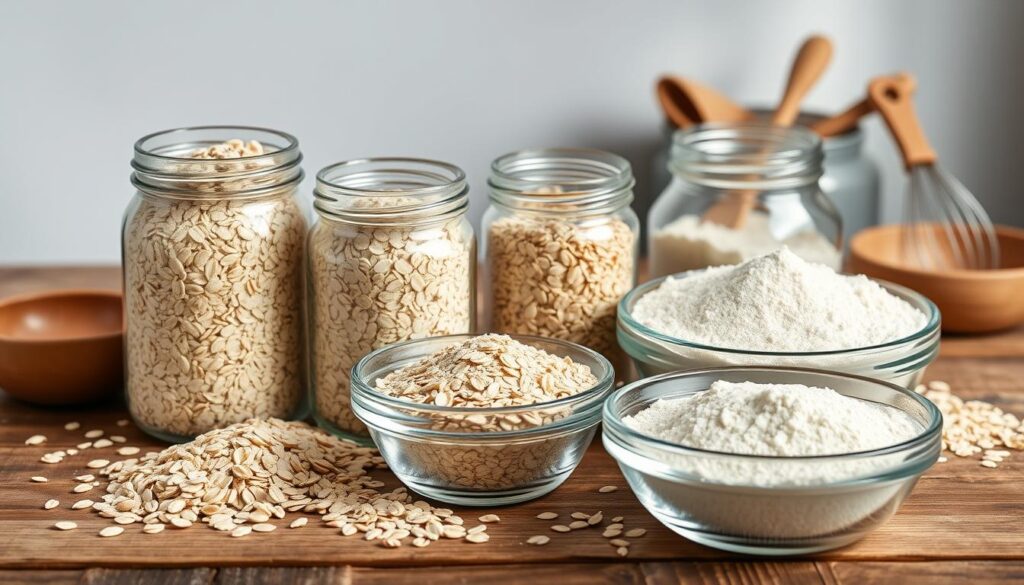
Essential Kitchen Tools and Ingredients
Making yummy and healthy baby food oatmeal is simpler than you think. You just need a few basic kitchen tools and ingredients. This way, you can make the perfect first food for your baby. Let’s look at the key items you should have.
Kitchen Tools for Homemade Baby Oatmeal
- High-powered blender or food processor: This makes your homemade baby oatmeal smooth and creamy.
- Measuring cups and spoons: You need these for the right amount of ingredients.
- Saucepan: It’s used for cooking the oatmeal and other ingredients.
- Whisk: This tool is key for mixing everything well.
Essential Ingredients for Homemade Baby Oatmeal
The main ingredient is oatmeal cereal baby. It’s important to pick the right oats. They come in steel-cut, rolled, or quick oats, depending on your baby’s age and taste.
You’ll also need a liquid like water, breast milk, or formula. As your baby gets older, you can use whole milk. Adding fruits, vegetables, or nut butters can make your homemade baby oatmeal taste better and be more nutritious.
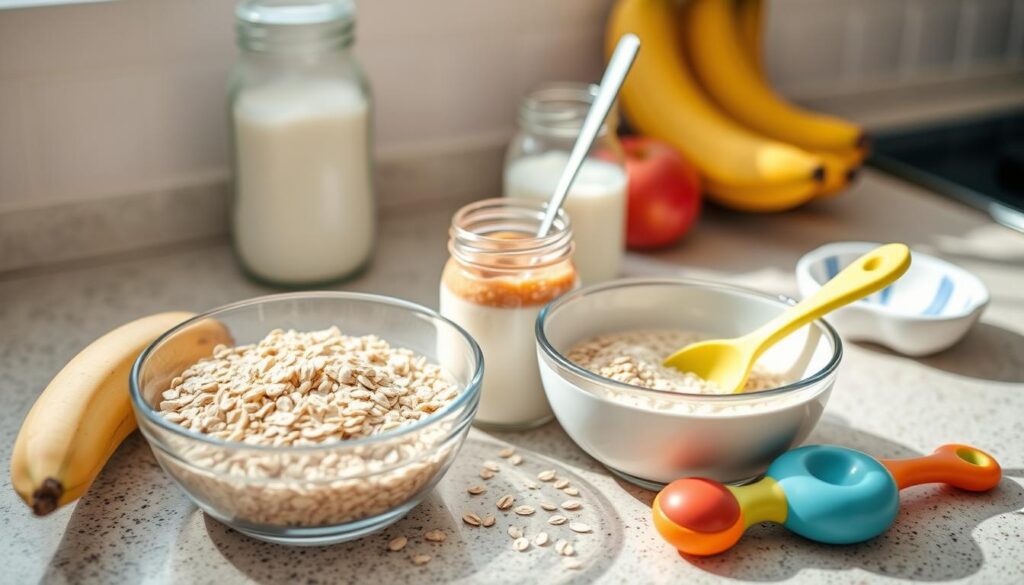
“Making homemade baby food is a fantastic way to ensure your little one receives the best possible nutrition. With the right tools and ingredients, you can create delicious and nutritious oatmeal that your baby will love.”
With these basic tools and ingredients, you’re ready to make tasty and healthy baby food oatmeal at home. Your baby will love it, and it will help them grow strong and healthy.
Basic Baby Oatmeal Recipe
Making homemade baby oatmeal is easy and healthy. It’s an excellent way to introduce your baby to whole grains. With a few ingredients and some basic steps, you can make a tasty oatmeal your baby will enjoy.
Step-by-Step Preparation Guide
- Begin by grinding 1/2 cup of whole oats into a fine powder. Use a blender or food processor.
- Next, heat 1/2 cup of water in a small saucepan over medium heat until it boils.
- When the water boils, mix in 1.5 tablespoons of oat powder. Cook for 3-5 minutes, stirring often, until it’s creamy.
- If it’s too thick, add a bit more water or milk to get the right texture.
Proper Consistency Tips
The best baby oatmeal is smooth and creamy. Start with a 1:3 ratio of oat powder to liquid. Then, add more liquid as needed to get the perfect texture.
Storage and Reheating Instructions
You can store leftover oatmeal in an airtight container in the fridge for up to 3 days. To reheat, add a splash of milk or water and stir until warm. You can also freeze it in portions for up to 3 months and reheat as needed.
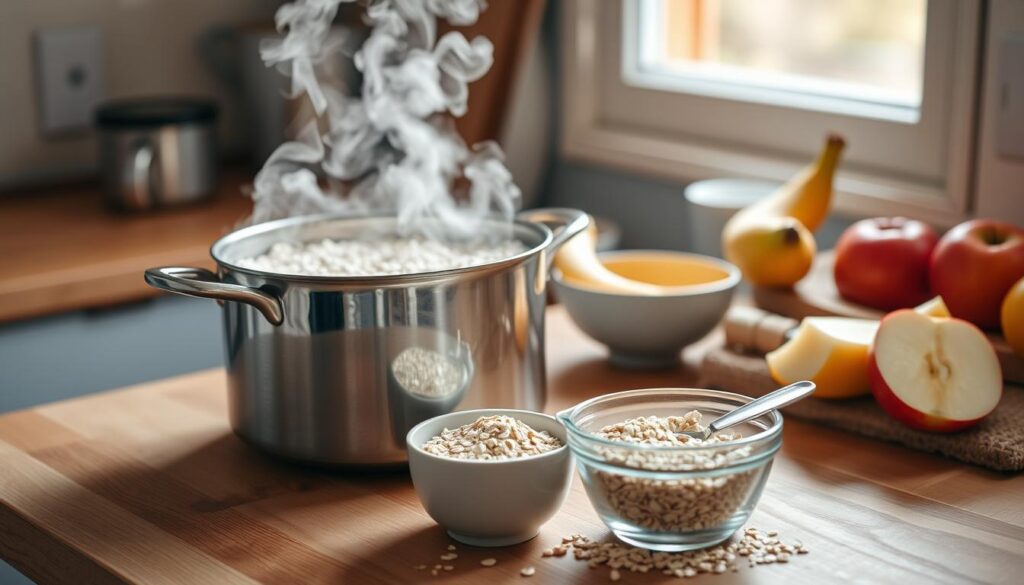
By making this infant oatmeal recipe, you give your baby a nutritious first food. It supports their growth and development. Try different flavors to make mealtime fun and help your baby love oatmeal for babies.
Creating the Perfect Texture for Different Ages
As your baby grows, it’s key to change the oatmeal texture to fit their age. For 6-month-old babies, make the oatmeal thin and runny. This makes it easier for them to swallow.
When your baby is 8-9 months old, start to thicken the oatmeal. Add small, soft lumps to help them learn to chew and feed themselves.
By 1 year old, your baby can handle thicker, chunkier oatmeal. Mix in soft fruits or veggies. This helps them chew better and gets them ready for more textures in their food.
| Baby’s Age | Oatmeal Texture |
|---|---|
| 6 months | Thin, runny consistency |
| 8-9 months | Thicker with small, soft lumps |
| 1 year | Thick, chunky with soft fruit or veggies |
The consistency of baby cereal is very important. Start with a smooth texture and gradually add thicker bites. This helps your baby’s chewing and swallowing skills grow.
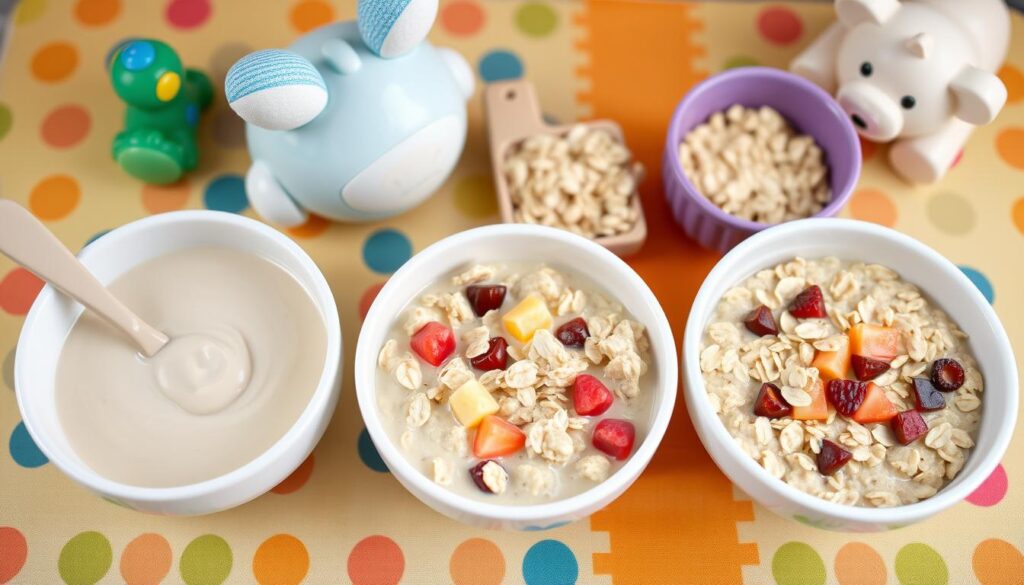
“The right texture can make all the difference in your baby’s feeding experience and overall nutrition.”
Fruit and Vegetable Combinations for Baby Oatmeal Recipe
Feeding your baby is all about variety. Incorporate healthy fruits and vegetables into your oatmeal recipes. Try apples, berries, and more to give your baby new tastes and nutrients.
Apple and Pear Variations
Diced apples and pears are great in baby oatmeal. Cook them with the oats or mix in a puree for a smooth meal. Their sweetness complements the oatmeal, making it a tasty and healthy choice.
Berry-Based Recipes
Blueberries, raspberries, or strawberries can add flavor and antioxidants to oatmeal. Mix in the berry puree after cooking or blend it in for a creamy dish.
Vegetable Integration Tips
Pureed veggies like sweet potato or carrots can boost nutrition in oatmeal recipes. They add vitamins and minerals and make the oatmeal creamy.
Always introduce new foods one at a time and watch for allergies. With creativity and healthy ingredients, you can make fruit and vegetable combinations for baby oatmeal that your baby will love.
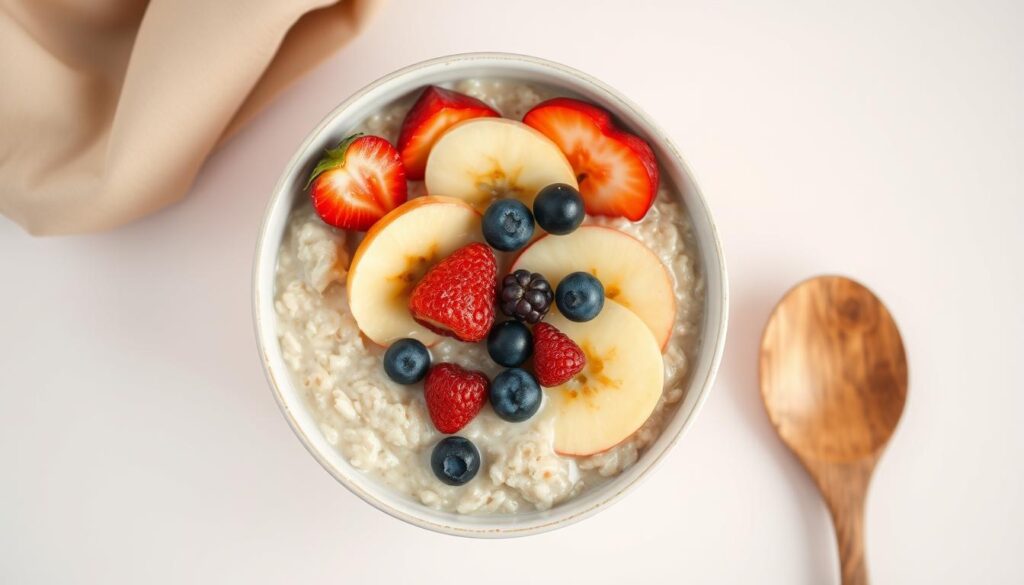
Adding Protein and Healthy Fats to Oatmeal
Make your baby’s oatmeal more nutritious by adding protein and healthy fats. These ingredients are key for growth and keep your baby full. They also make your little one feel happy and content.
Adding a bit of unsweetened nut butter, like peanut or almond butter, is easy. Just watch out for allergies and talk to your pediatrician first. Greek yogurt is another great protein source to mix in.
For healthy fats, try adding ground flaxseed or chia seeds. These tiny foods are full of omega-3s and other good stuff. A little coconut oil can also add healthy fats.
Always check with your pediatrician before trying new foods, including these. With a bit of creativity, you can make your baby’s oatmeal a nutritious, protein-rich meal. This supports their growth and health.
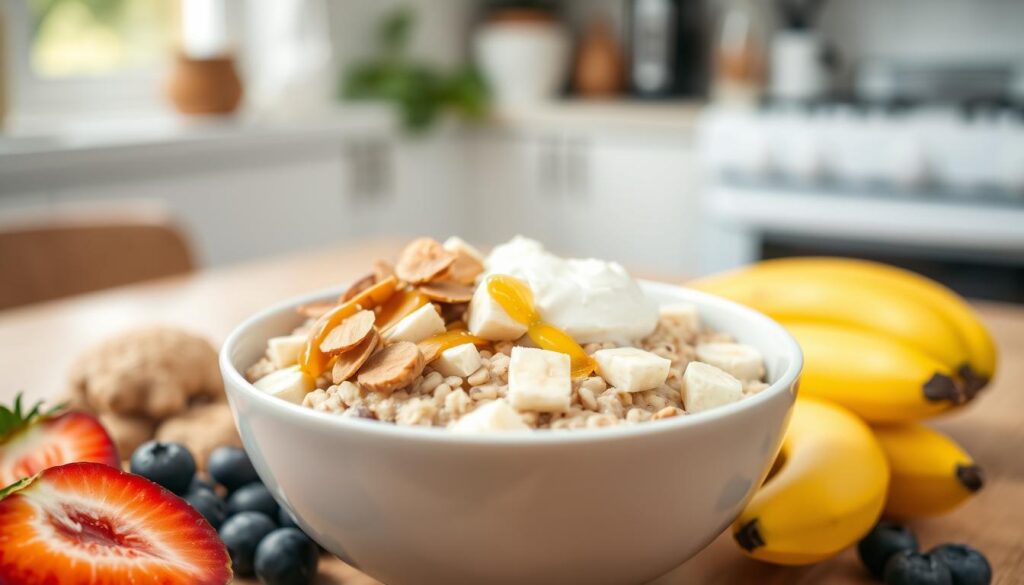
“Incorporating protein and healthy fats into your baby’s oatmeal is a simple way to boost the nutritional value and keep them feeling satisfied.”
Safe Storage and Meal Prep Tips
Storing and prepping homemade baby oatmeal can be easy with a bit of organization. To keep your baby’s food fresh and healthy, just follow these simple steps:
Refrigerator Storage
Keep prepared baby oatmeal in airtight containers in the fridge for up to 3 days. This way, you can make big batches and portion them out for the week.
Freezing for Meal Prep
- Make extra oatmeal and freeze it in portions using ice cube trays or silicone molds.
- Frozen oatmeal lasts up to 3 months, making it a quick and nutritious meal option.
- To thaw, leave it in the fridge overnight or reheat it, adding more liquid if needed.
| Storage Method | Maximum Storage Time |
|---|---|
| Refrigerator | 3 days |
| Freezer | 3 months |
By using these baby food storage and meal prep for baby oatmeal tips, your baby can enjoy homemade oatmeal’s nutritional benefits. Freezing baby oatmeal is a lifesaver for busy parents!
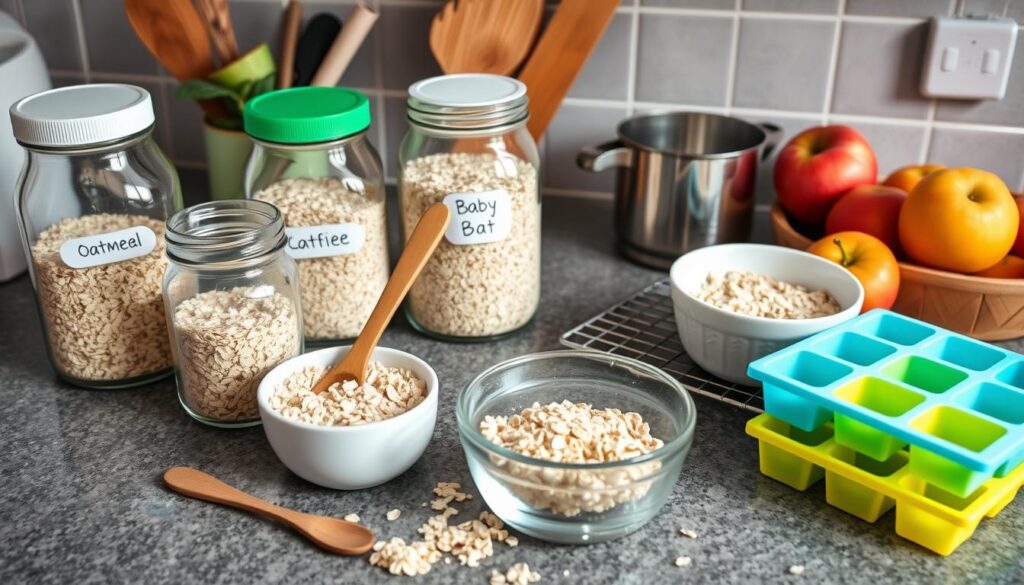
Common Mistakes to Avoid When Preparing Baby Oatmeal
When making homemade baby oatmeal, it’s key to watch out for common mistakes. Avoid adding sugar or salt, as babies don’t need these. Also, don’t overfeed your baby, as too much oatmeal can cause discomfort and even blockages.
Introducing new foods and textures slowly is important. Follow your pediatrician’s advice and add new ingredients gradually. This helps your baby’s digestive system adjust and lowers the risk of allergies.
Always check the oatmeal’s temperature before serving. Babies’ skin is very sensitive, and hot oatmeal can burn them. By avoiding these baby oatmeal mistakes, you can make sure your baby enjoys this healthy food safely.
FAQ
What are the benefits of baby oatmeal?
When can babies start eating oatmeal?
What types of oats are best for baby food?
How do you make homemade baby oatmeal?
How do you adjust the texture of baby oatmeal?
What can you add to baby oatmeal for extra nutrition?
How do you store and reheat homemade baby oatmeal?
What are some common mistakes to avoid when making baby oatmeal?
Source Links
- Easy Baked Pears (to Share with the Kids)
- Healthy Banana Bread
- Can I give my baby porridge? (Includes 5 easy recipe ideas) – Solid Start
- Three Ingredient Banana Pancakes | BLW & Toddler Recipes
- Healthy Snack Ideas for Toddlers and Baby Led Weaning Recipes
- 14 Nutritious and Delicious Oatmeal Recipes for Babies – Richmond Mom
- Oatmeal For Babies: Types, Benefits, And Recipes To Try
- Oats Upma Recipe (Healthy Savory Oats)
- Porridge for Babies (Baby Cereal)
- The Key Ingredient That Makes These 3-Ingredient Pancakes So Delicious
- Blueberry Baked Oatmeal
- Healthy Snack Ideas for Toddlers and Baby Led Weaning Recipes
- Baby Led Weaning Egg Cups – Choosing Balance
- Avocado Blueberry Smoothie – The Lemon Bowl®
- No-Bake Oat Bars | Baby Led Weaning & Toddler Recipes
- Healthy Snack Ideas for Toddlers and Baby Led Weaning Recipes
- Steel Cut Oats | How to Cook the Perfect Bowl
- How To Cook Oatmeal With An Egg In The Microwave
- 3 Easy and Healthy Breakfasts for Athletes | TrueSport
- Baked Sweet Potato Oatmeal
- No Bake Peanut Butter Banana Oat Bars – Slender Kitchen
- Oatmeal Breakfast Bars
- Is It Safe To Consume Oats During Pregnancy?
